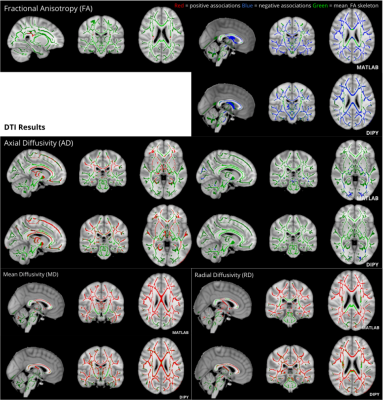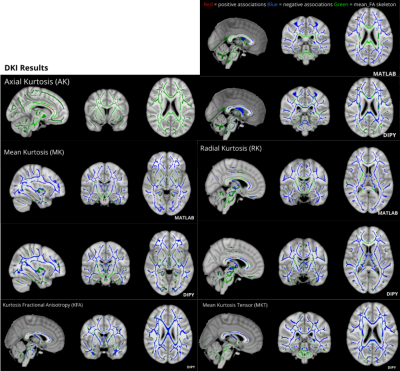Hiba Taha1,2, Jordan A. Chad2,3, and J. Jean Chen2,3
1Human Biology, University of Toronto, Toronto, ON, Canada, 2Rotman Research Institute, Baycrest Health Sciences, Toronto, ON, Canada, 3Medical Biophysics, University of Toronto, Toronto, ON, Canada
1Human Biology, University of Toronto, Toronto, ON, Canada, 2Rotman Research Institute, Baycrest Health Sciences, Toronto, ON, Canada, 3Medical Biophysics, University of Toronto, Toronto, ON, Canada
Age-associated increases in diffusivity and decreases in kurtosis are observed in a large cross-sectional sample using two different DKI software packages: Matlab Toolbox and DIPY Tool. Differential results captured by these tools suggest that the DKI software package used affects results.

Figure 1. Matlab Toolbox and DIPY derived age-associated significant diffusion metric changes (p<0.05) across the WM skeleton presented in radiological orientation. Diffusion metrics mostly increased with age, with the exception of FA which showed reductions throughout the WM skeleton, and AD which showed specific reductions in posterior regions. FA increases in the right and left corticospinal tracts were also observed using Matlab only.

Figure 2. Matlab Toolbox and DIPY derived age-associated significant kurtosis metric changes (p<0.05) across the WM skeleton presented in radiological orientation. Kurtosis metrics mostly decreased with age, with the exception of AK increases captured by DIPY only in the corpus callosum. Additional kurtosis metrics KFA and MKT were available for computation using DIPY only, showing age-associated decreases.